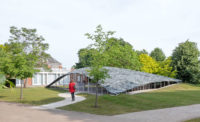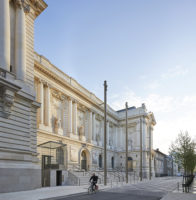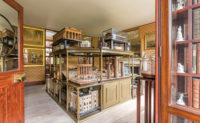Bad M'nster am Stein-Ebernburg, Germany
It has been more than 20 years since stone sculptors Wolfgang Kubach and Anna Kubach-Wilmsen conceived the museum that now sits next to their home on a 4-acre plot above Bad M'nster am Stein-Ebernburg, Germany. But the project's construction history begins much earlier, in 1785, with the erection nearby of a field barn. This rustic structure has been resurrected by Japanese architect Tadao Ando as the roof and upper story of a building that has deep affinities with its contents and its setting.
The sculptors' longstanding aim has been not simply to use stone as a material but to reveal it as matter, the product of a living earth. Manifesting time and nature in built form has also been one of Ando's consistent preoccupations. By registering changes in the weather and the seasons in his buildings, the architect heightens awareness of the passing moment and, in the process, 'allows us to glimpse the eternal,' he wrote in an essay several years ago. At the Stone Sculpture Museum, he reprises familiar devices to that effect: shadows of passing clouds animate smooth expanses of concrete; wind-driven ripples disturb the surface of a reflecting pool. The juxtaposition of these elements with the reclaimed barn amplifies the project's historical character, making it at once recognizable and new. 'By having such a shape, and the structure visible from inside and outside,' Ando says, 'the building harmonizes with nature and with tradition, and provides a sense of familiarity and warmth to local people.'
The barn was a late addition to the design: Ando's first proposal, in 1996, was for a half-buried, top-lit concrete box. This proved too expensive, and the project stalled. Almost a decade later, with more money, the clients persuaded him to revise it. 'That is when I recalled Wolfgang Kubach's request to somehow use the wood structure of the surrounding barns,' Ando explains. Local inquiries led the sculptors to a dismantled barn lying in storage, together with photographs and drawings of the original 1,700-square-foot building.
The old building's scarred timber frame now sits on crisp walls of fair-faced concrete with precisely spaced formwork tie holes. Below the flared eaves of a new slate roof, the woodwork of the long flanking walls is infilled with clay bricks and plaster. At each gable end, the timber is expressed as a brise-soleil, set in front of aluminum-framed, glass curtain walls. Rotten wood from the frame was replaced with new pieces; brown paint gives all the wood elements a uniform appearance.
The smallness of the barn and its clarity of form belie the rich variety of spaces inside and around the $1.5 million museum. The building is wrapped by three sets of freestanding concrete walls that are nested or interleaved to produce three courtyards'one behind and two in front'and suggest a promenade route through the compound. The tops of the walls impose a horizontal datum running the length of the site, while floor levels step down with the slope of the ground.
Immediately in front of the building, a shallow pool of water reflects a stone needle, Axis Mundi, sculpted by Kubach-Wilmsen. In the other courtyards, sculptures are planted in gravel, like rocks in a Zen garden. The influence of traditional Japanese gardens is also evident in the use of 'borrowed scenery,' views through a series of rhythmically placed openings in the concrete perimeter walls that connect the microcosm of the garden to a sculpture park beyond.
Internally, the museum is quietly dramatic. From the entrance, visitors pass through a closely confined space below a mezzanine before emerging in the full-height main gallery, where the heavy presence of a concrete ceiling gives way to an eccentric tracery of gnarled timbers overhead. A second moment of revelation comes in ascending to the mezzanine. On the ground floor, views out are carefully controlled: two picture windows look into the courtyards in front and back of the building, but deep architraves frame the scene to exclude the sky, suggesting a continuous interior. From the upper level, the glazed gable opens up a spectacular prospect of the winding river valley below and, opposite, a sheer 650-foot cliff of reddish porphyry.
The museum is almost entirely daylit and, as stone sculptures require no special climatic control, unheated and naturally ventilated. The subtle colors of the stone stand out against the architect's muted palette. It was the reticence of Ando's work that first appealed to the sculptors, who had visited several of his buildings before engineering a meeting while exhibiting in his home city, Osaka. The architect was impressed by the site, but the budget'then $650,000'was insufficient. Just as it seemed there was nothing more to say, recalls Kubach-Wilmsen, her husband seized a Hindu sacred stone from the corner of Ando's office and wordlessly placed it before the astonished architect. Ando understood the gesture: banging his fist on the table, he declared, 'I will build your museum.'
The project's slow gestation was sustained by passion and patience, even after Kubach's death in 2007. This commitment is evident in every material aspect, from the almost velvety finish of the concrete to the care with which the idiosyncrasy of the 18th-century frame has been preserved, even as it is coupled to a modern glazing system. And it is evident in the delicate tension of the architectural composition; visitors experience Modernist spatial fluidity in the same instant as evocations of the cave and the primitive hut. Its unfixed age and air of cloistered calm make this a fitting home for the Kubachs' reflections on transience and deep time.
Chris Foges is the editor of the London-based journal Architecture Today.
Close Up: Re-assembled Roof
| Photo © Shigeo Ogawa |
| Timbers from an old barn were used for the new roof. |
Barn Raising
The 18th-century frame used for the roof was pieced together on the ground, where rotten timbers—fewer than a fifth—were replaced with oak from other old structures, then placed atop concrete walls. The connection is made by steel hidden in the uprights, with additional bracing at the corners. Windows are supported by steel frames between the glazing and the oak. Connections between the steel and wood help stabilize the timber structure. The loose fit of the glass walls allows natural ventilation of the unheated building. The architects had hoped to use a traditional method for the upper walls, packing the frame with twigs and clay. This proved too costly, so they used clay bricks with clay plaster instead.
Completion Date: August 2010
Gross square footage: 2,315 square feet
Total construction cost: $1.5 million
Client: Wolfgang Kubach and Anna Maria Kubach-Wilmsen
Architect:
Tadao Ando Inc.
PeopleClient: Wolfgang Kubach and Anna Maria Kubach-Wilmsen
Architect: Executive Architect: Dorian Zapp, Bodo Zapp
Consultant: Ars Ligni (historical wood construction) Contruction Manager: Ingenieurbüro JRN
Photographer(s): |
ProductsGable Wall Glazing: Schüco Concrete: Trapobet Glass Balustrades: Hera Glas Panoramic windows: Sitec Glas |
















Post a comment to this article
Report Abusive Comment